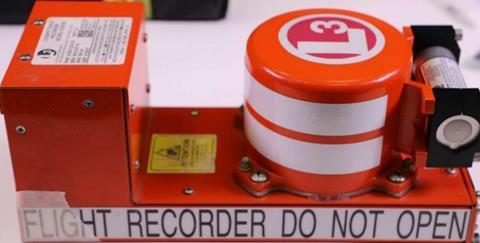Russian investigators have not been able to determine whether a deliberate attempt was made to erase the cockpit-voice recorder of a Nordwind Airbus A321 after a hard landing in Antalya, by fitting it into a different aircraft.
The recorder had been present on the A321 (VQ-BRS) as it flew – without passengers or cargo – from Moscow Sheremetyevo to Antalya on 10 January 2020.
As the aircraft’s crew conducted a manual approach to Antalya’s runway 36C, with autopilot and autothrottle disengaged, the airspeed began to fall significantly in the changing wind conditions, and the approach became unstable.
But instead of executing a go-around, the captain pushed the side-stick forward and the aircraft entered a nose-down attitude, contacting the runway initially with its nose-wheel.
The 2.64g impact inflicted substantial damage – and caused several failures, including blanking of the captain’s displays and a switch to direct flight law – but the crew initiated a go-around.
Hydraulic circuits on the A321 failed during the go-around but, after the jet conducted a pass for visual confirmation of the landing-gear position, it touched down safely on runway 36C despite the loss of several systems. None of the seven crew members was injured.

Russia’s Interstate Aviation Committee says both the flight-data recorder and cockpit-voice recorder were in place when the inquiry commission inspected the A321.
But when the cockpit-voice recorder was initially read, the data received indicated that the ‘erase’ button for the recorder had been pressed in the cockpit.
The inquiry says just over 2h 4min of information was obtained from the recorder but, after decoding, the trace of the Moscow-Antalya flight was found to be “absent”.
Instead there was a recording of a different flight involving another Nordwind A321 (VP-BHN), operating an Antalya-Moscow service on 11 January 2020, the day after the accident.
The cockpit-voice recorder also picked up subsequent conversations in Russian by ground personnel during maintenance activity on 11-12 January.
Further conversations on 13 January, in Russian and English, included discussions about pressing the cockpit ‘erase’ button.
The inquiry found that both the cockpit-voice and flight-data recorders were “repeatedly moved” between the accident aircraft, the warehouse of a maintenance entity called RMS Technic, and the second A321 while both jets were parked in Antalya.
According to the Interstate Aviation Committee, this was done “for the purpose of reading information”.
But it adds that the cockpit-voice recorder remained on VP-BHN when it flew to Moscow on 11 January.
“It was not possible for the commission to establish whether this was done intentionally – to erase the flight record [of the hard landing] – or accidentally, out of forgetfulness,” it says.

The inquiry found that the recorder was removed from VP-BHN on 12 January, by personnel from maintenance firm NV Technik. It was then flown in hand luggage aboard an Aeroflot service to Antalya, and probably handed to RMS Technic personnel, who reinstalled it on the A321 involved in the accident before investigators arrived.
Loss of the cockpit recorder information, the inquiry concludes, was the result of “non-compliance” with accident investigation procedures, by officials of the various organisations – Nordwind, NV Technik and RMS Technic – including the prohibition on opening and accessing the flight recorders before investigators had arrived.
Specialists of NV Technik, it says, provided “fragments” of information which they had obtained from the cockpit recorder, and these were decoded with the assistance of the recorder’s manufacturer, L3 Communications.
Analysis found just over 10min of audio data relating to the accident flight, including crew communications with Ankara air traffic control, and conversation between the pilots on such topics as holidays in Antalya. The inquiry adds that “various musical compositions” were also recorded.


























